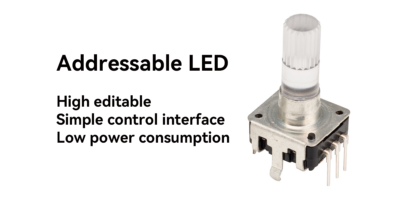Modules are essential components in modular synthesizers, which are a type of synthesizer where individual functions like oscillators, filters, amplifiers, and so on are divided into different modules. These modules can be connected in various ways using patch cables to create complex sounds.
A modular synthesizer is comprised of an array of components including knobs, sliders, LED tactile switches, 3.5mm jacks, patch cables, input and output ports, switches, LED indicators, digital displays, USB ports, Eurorack power connectors, trim pots, IC chips, transistors, capacitors, resistors, and microcontrollers. While each part serves a function within the module’s ecosystem, LED tactile switches play an important role in the control aspect of these modules, offering users a tangible means to interact with their electronic music creations.
What are LED Tactile Switches?
LED tactile switches are a type of push-button that offer a dual sensory experience. They provide a distinct physical response when pressed, thanks to an internal mechanism that gives a ‘click’ feedback. Simultaneously, they incorporate an integrated LED to deliver visual feedback. This combination of tactile and visual cues makes them exceptionally useful in scenarios where both physical interaction and visual indicators are essential. These switches are ideal for environments where clear and immediate feedback is crucial, enhancing both functionality and user experience.
In modular synthesizers, LED tactile switches serve multiple purposes:
- Visual Feedback: The LED provides immediate visual feedback that is especially useful in live performance situations, where lighting conditions may not be ideal. Musicians can easily see which parts of the synthesizer are active, and the color coding can further assist in navigation.
- Tactile Response: The tactile nature of the switch allows for precise control over the synthesizer’s functions. When programming a patch or performing live, the accurate response of a tactile switch is essential for nuanced adjustments.
- Aesthetic and Functional Design: Modules with LED tactile switches often follow a design philosophy that marries form and function. These switches contribute to a clean and modern aesthetic while maintaining the practicality of use.
- Durability: High-use environments like music studios and performance venues demand hardware that can withstand constant interaction. LED tactile switches are designed to endure, ensuring that modules retain their functionality over time.
The TL1 Series in the Spotlight
The TL1 Series of LED tactile switches are widely used in Modules for their reliability and the bright, clear illumination they provide, making Modules easier to access and operate and helping to enhance the overall user experience.
The Future of Modular Synthesis
As modular Modules continue to evolve, the importance of components such as the TL1 series of LED tactile switches becomes increasingly apparent. They are small but critical elements that contribute to the greater whole, enabling musicians and producers to bring their aural visions to life with clarity and precision.
Conclusion
While they may only be part of what makes up Modular Modules, LED tactile switches like the TL1 series play a crucial role in the design and function of these fascinating instruments.
If you want LED tactile switches to help you add to your modules welcome to contact us.
If you would like more people to see this article, please feel free to forward it to the social media platforms below.
Click here to view related products




3 thoughts on “LED tactile switches are important components of the synthesizer modules.”
Hurrah! Finally I got a weblog from where I be able to truly take useful data regarding my study and knowledge.
That is a good tip especially to those new to the blogosphere.
Short but very precise info… Thanks for sharing this one.
A must read article!
It’s actually a nice and useful piece of info.
I am happy that you just shared this helpful info
with us. Please keep us informed like this. Thanks for sharing.